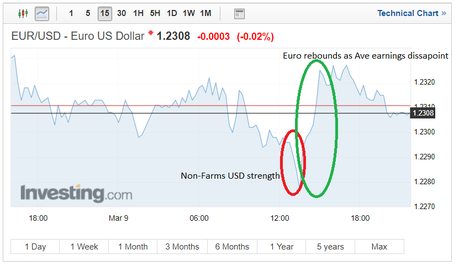Friday saw a raft of US economic data releases; these included Non-farm payroll figures, average hourly earnings and US unemployment rate. Much of the US economic strength has been attributed to the US’s jobs market which has continually been promoted by Trump, an area which has been weaker, however, has been wage growth and would appear alongside inflation to be a cause for concern and potential reasons to delay a US interest rate hike.
Non-farm payroll figures
The US non-farm payroll figures have long been scrutinised by the Federal reserve bank and investors as to indicate where the economy is heading. Essentially if people are working, they have money to spend and the majority of US economic growth is attributed to consumer spending.
Last month’s non-farm payrolls reached 200k coming in on target, the previous disappointed reaching just 148k against a target of 190k. This month’s figure was anticipated to reach 205k but greatly surpassed this target, demonstrating that 313k had found themselves back in work this month.
The significant upturn highlighted the largest US labor increase since 1983. Whilst the outstanding numbers will provide great ammunition for FED rates hawks, markets remained more consumed with the hourly wage figures which have diluted the overall view of the US labor market.
The US non-farms record-breaking month was helped along nicely by a handful of job sectors, these included Construction up by 61,000 new positions, business services and professional service which both registered increases of around 50,000, manufacturing increased by 31,000 and health care which increased by 19,000 posts.
US wage growth

Alongside inflation wage growth has provided the biggest bugbear for the Federal reserve bank in terms of continual recovery. Average hourly earning’s annualised figures sit at 2.6%. This months average earning figures followed a buoyant January which showed an increase in average earnings of 0.3%, many had a close eye on this month’s data in order to decipher whether or not more arguments for quicker rates hike or even larger rate hike could be implemented. Regrettably for rate hawks, the figures have been an unwelcome return to weaker earnings growth and therefore have weakened the chances of a rate hike, at least before May. This month’s average hourly earnings data showed a slump by -0.1% and provoked a reaction from Euro-Dollar FX Rates.
Unemployment rate
US unemployment held firm this month although technically missing its target of 4.0%, this will be of little concern for market makers and investors. The US unemployment rate has been static for 4 months now, sitting at 4.1%. US unemployment remains at it lowest level since December 2000. Steady unemployment combined with increased job numbers should eventually translate to higher inflation numbers. The main concern will surround struggling wage growth which has struggled to become sustainable, although Trumps tax cut should translate into more consumer spending power and fuel spending this will be dismissed until its demonstrated through consumer spending figures.
Euro-Dollar FX rate reactions
Despite the bumper non-farms payroll figures, the US dollar was unable to capitalise on the positive data. Market makers remain much more focused on inflation and wage growth which have now become the key sways towards US interest rate hikes. Upon the release of Friday’s US economic data the Euro-Dollar FX rate fell from 1.2296 the week high for the dollar and moved to 1.2298 before spiking significantly upon the release of the Average wage growth figures. The week’s Euro-Dollar FX rate closed at 1.2308 with the dollar wrestling back some of the losses.


